
By Ruth
Buying an American school bus and bringing it to the UK is not for the faint-hearted. It takes a lot of time, skills, creativity and contacts to turn an old retired yellow bus from a different continent into a rural bolt hole in the UK. Luckily, after travelling 14,000 miles across America in our first Skoolie, we had the confidence, ability and network to take the plunge and buy bus number 2 and launch our new business: Skoolie Stays.
Buying an American school bus from the UK

There was a sense of de-ja-vu when it came to purchasing a new bus. It felt very different this time though because of the financial risk. The major cost of a Skoolie project is not in the purchase of the bus – ex-school buses are plentiful in the States, so they are good value – it’s in the shipping and conversion. We needed to be sure we picked a good bus that would be worth the investment we were ready to make. When we found a bus in Florida that had our choice of engine, transmission and had the ‘dog-nose’ look we like (rather than flat-faced), as well as the interior height we sought, we had our friends check it out before we put it on the ship over to Southampton.
In America, you buy your bus and then convert it before applying to change the registration from bus to a private vehicle. You get your insurance and hit the road. It’s a slightly more complicated process in the UK. You need an HGV license for a start. You also need to navigate the confusing world of DVLA guidelines about MOTs and imported vehicles to get your bus registered. Long story short, you need to get your MOT certificate before you begin your conversion as it needs to look like a bus in order to be assessed as a bus. We had to make a few changes to fit within UK rules and regs, but we sailed through our test and were able to send off our paperwork for registration. A few weeks later. we had our plates.
Stay before you buy? We can help!
When your ideas are getting serious, why not come and stay with us? Spend a couple of days and nights on our Skoolie Stay. Check that head-height, get a real idea of how solid it is…and how big. Big enough? Sit and think about layouts, why not bring a measuring tape! Get in the drivers seat and try it out for size. Can you really imagine driving one? Pick up the books on the bookshelf about Skoolie builds and our own project and meditate on your future adventure. Does you other half need persuading? Here’s a surprise weekend away that’ll help! Get in touch now and we’ll help you out with this and a friendly chat about your own school bus buying ideas. Or just check prices and book now, and give us a shout when you are ready. – Guy & Ruth
OK, read on about how to buy your own ‘Skoolie’!
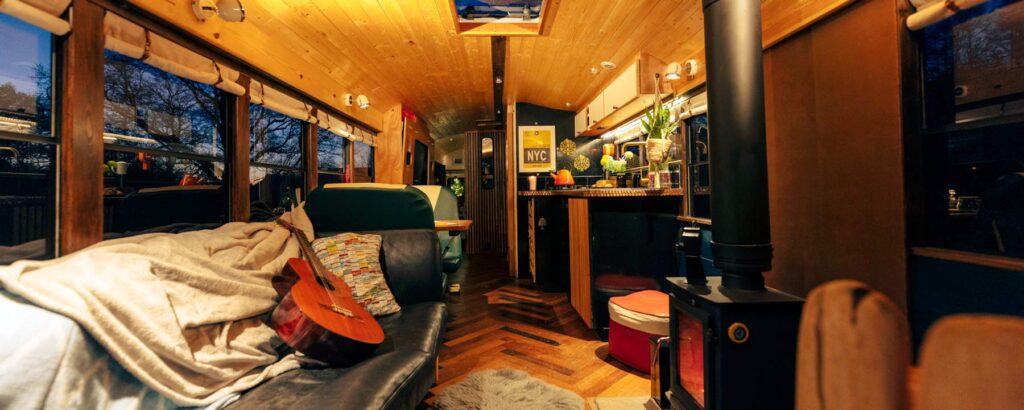

First conversion job: stripping the bus

Seat removal is the first place to start with a Skoolie conversion but it’s a nasty job. Our seats were bolted onto rails, which meant they came out easily, but the rails themselves also had to go and the bolts were tricky to shift.
It took us 3 filthy and exhausting days to remove some 500 bolts. Each one had to be angle-grinded and then hammered or drilled out. Mercifully, the wooden sub-floor was easy to wrench up. We’ve seen plenty of builds in which this stage is even worse – the glue refusing to let go of either surface – so we thanked the Skoolie gods and pulled it all back for the big reveal. What state was the floor in?
The condition of the floor is always a bit of a unknown when buying your bus. You can get an idea of rust from a survey of underneath and around the edges, but you never know until you rip the floor up what kind of state the bus will be in. It can be an expensive disaster to find a rusty, holey mess. The best way to prevent that, especially if you are buying remotely, is to purchase a bus from somewhere that stays warm(ish) and is not too near the sea, and that is built to drive on terrain similar to that which you will need it for. It’s no good heading to the Alps in a city bus that is designed to stop and start on flat roads!
Our floor was thankfully brilliant – just a touch of surface rust which is exactly what you’d expect. We sanded back the surface then treated it with de-greaser before spraying it down with a specialist metal prep. All the holes left by the bolts were filled with bits of old bus metal and pennies (the perfect size) and with the whole floor deemed waterproofed, we covered everything with a rust preventative paint, which is totally resistant to road salt, petrol, battery acid, etc, before adding a gloss top coat (which took forever to dry in the February snow!). g
Back to the metal ... and then out with half of it

Floor done, we moved onto the walls. All the unnecessary metal, fittings and insulation had to be removed, so there were a few more long days wielding angle-grinders, drills and hammers to remove the aircon units and the disabled door lift. Dirty, dusty, achey days.
We then started on the roof, removing the two emergency exits. Climbing out the hatch to the roof-deck was one of our favourite things to do in America. They are not designed to be opened and closed as regularly as we did though, so ours broke. We wanted to avoid that this time and, as we weren’t building a deck on top, decided to replace the front exit with a glass marine hatch and the rear with a campervan-style vent. Neither were the size of the hole left by the original hatch, so we patched the hole, made a new frame to support the marine hatch (out of old bus rails) and then cut through again to fit. It worked brilliantly and now we always have a view of the sky, even when it is closed.
With the hatches done, the roof was cleaned and sanded down. All the rivets and seams were coated with silicone before a fresh coat of military vehicle paint was applied. The white top, as well as looking traditional for a school bus and making it pretty for the birds and paragliders overhead, has the added benefit of reflecting the sun’s rays and keeping the bus cooler on hot days.
Taping out our planned layout
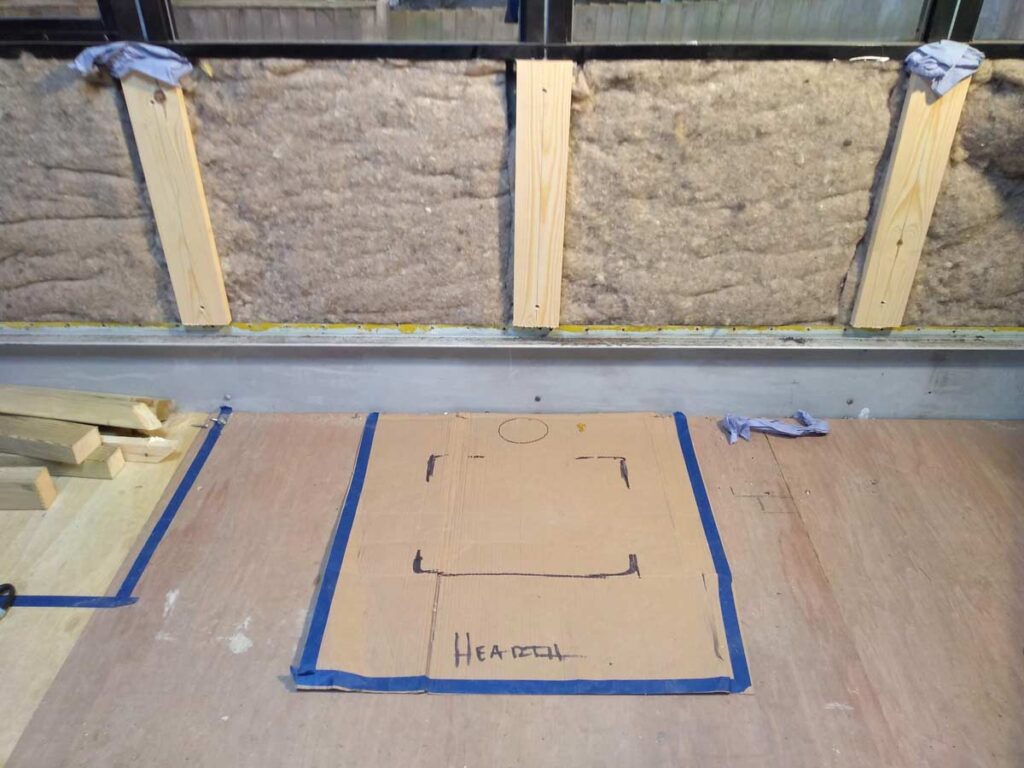
Once the interior was dry we put the insulation and the ply subfloor down. Suddenly it was starting to look like a useable space and we could dance around marking things out in tape. We had a plan already of course, but you never know how it will feel until you lay it out. Are those tight gaps workable? Can you squeeze anything better into that space?
Before we could get too excited, we hit a problem. We’d picked the worst time of year to begin our conversion. February was freezing but at least it was dry. March was wet, wet, wet. In this instance it was useful though. We arrived one soggy morning to find tell-tale wet spots below the windows. It could only mean one thing – leaky seals. This is a common problem, particularly with this style of window frame, and it was good that the issue was flagged up early in the build. Despite the foul conditions, Guy had to spend the day on a ladder re-sealing each one up while I dammed the drips with blue roll. When the wads of tissue came away dry, Guy was allowed back in again!
With a solid floor, sealed windows and our masking tape guides, we were able to start framing out the living space and lining the walls and ceiling with sheep’s wool insulation. We chose Cumbrian wool because of the eco-credentials. I also liked the idea of wrapping up the bus in a big woolly jumper, even though it smelt like a farmyard for a few days until we got the waterproof membrane taped on top.
Getting down and dirty with the plumbing and heating
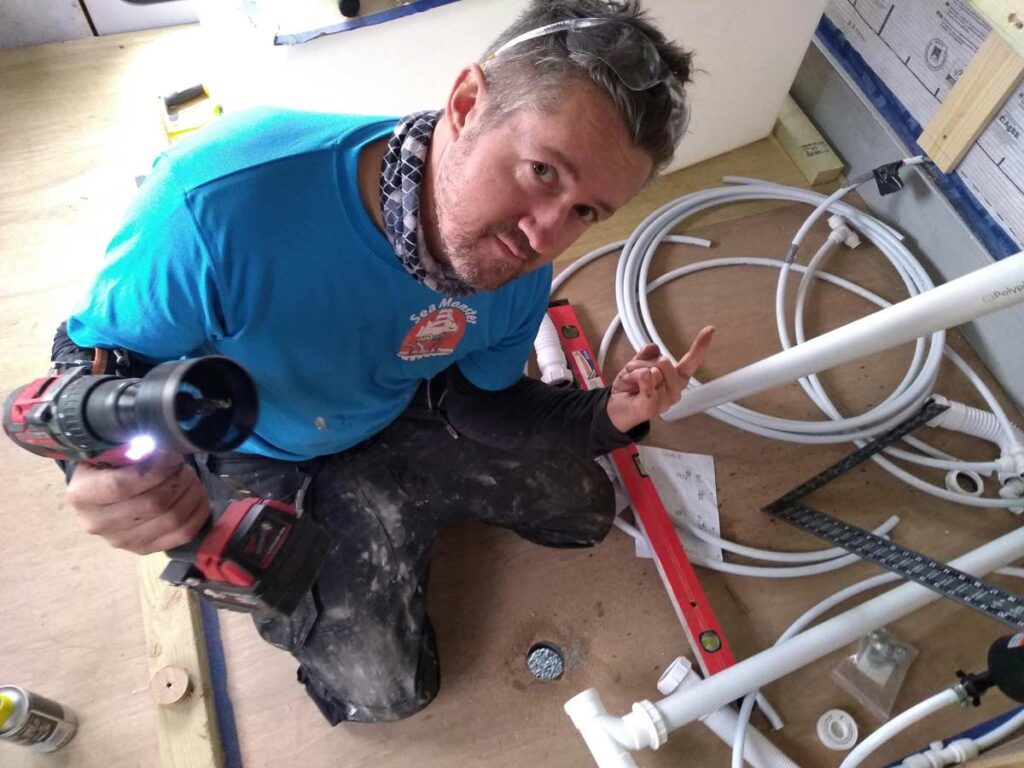
With the inside taking shape, Guy turned his attention to the plumbing for the water and heating. It was a tricky and messy period of the build and even though he had spent hours preparing detailed schematics and timelines for ordering, it was still an almighty challenge and nothing seemed to work quite as we had planned at the first pass. When you are building a bespoke conversion you can’t always buy things off the shelf and much of the time we ended up sourcing what we needed from companies who sold pond supplies or farming equipment. The measurements varied between imperial and metric, but also seemed to be dependent on different companies interpretations of how to measure. Things would arrive and be a mm too small or wouldn’t flex in the right way. It was endlessly frustrating and kept Guy on the laptop until late at night as that was the only time he had free to research and purchase new.
We got there in the end and once we had everything mounted and working, we set about rust-proofing the exterior underbelly with Lanoguard, a sheep-wool derived rust protector. It is a brilliant product and so much better than chemical protectors. Lanoguard even came down to help us apply it. We warmed up their thick grease and painted it on the bolt holes so that it could really soak in to the newly exposed areas, then set up the pressure spray to cover the bottom in a more diluted, thinner product. Mark and Jacob got under the bus with Guy, I went to make them all tea and by the time I came back they had finished and the bus looked brand new.
Fitting out the kitchen, bathroom and living room
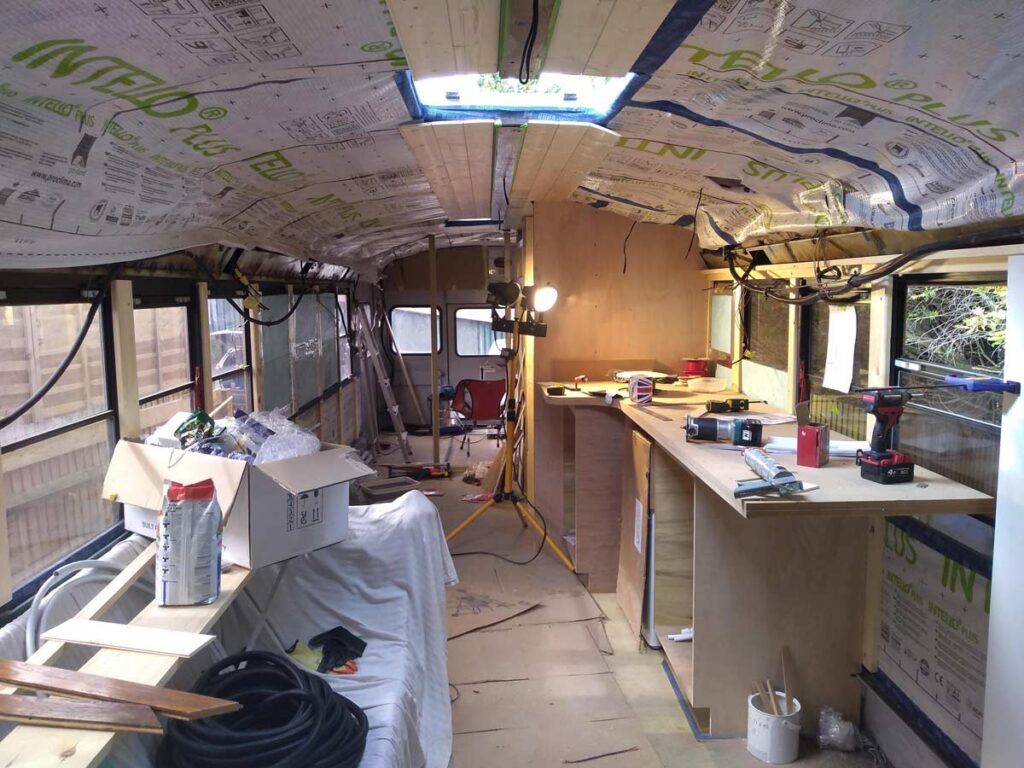
Back inside, the framing was done and we had the skeleton of a bedroom and bathroom, as well as a kitchen carcass. It was time to call in the specialists.
John arrived to help us with the tiling, spending days coiled up in the bathroom turning an empty space into a luxurious bathroom. Lots of people are not sure whether you can actually use ceramic tiles in a vehicle conversion, but as long as you use the right kind of flexible grout and sealant, it’s fine.
Once the bathroom was complete, we moved on to the panelled pine ceiling and made one of many last minute design changes that have gone on to become real features. This time it was to add a long wooden backbone down the length of the bus to help ensure the slats went in neatly and evenly, but also to provide a more solid base for our spotlights. It was time for the first fix electrics.
With Guy plumbing, John panelling, Neily working on the cabinets, Steve fitting the wiring, Marcus doing the LPG and Andy from Hove log burners lying prostate on the floor trying to fit the log-burning stove, it was quite timely that the Government chose that point to send the kids home from school. It was time for me to leave the boys and work from home!
Repurposing the bus seats and working from home
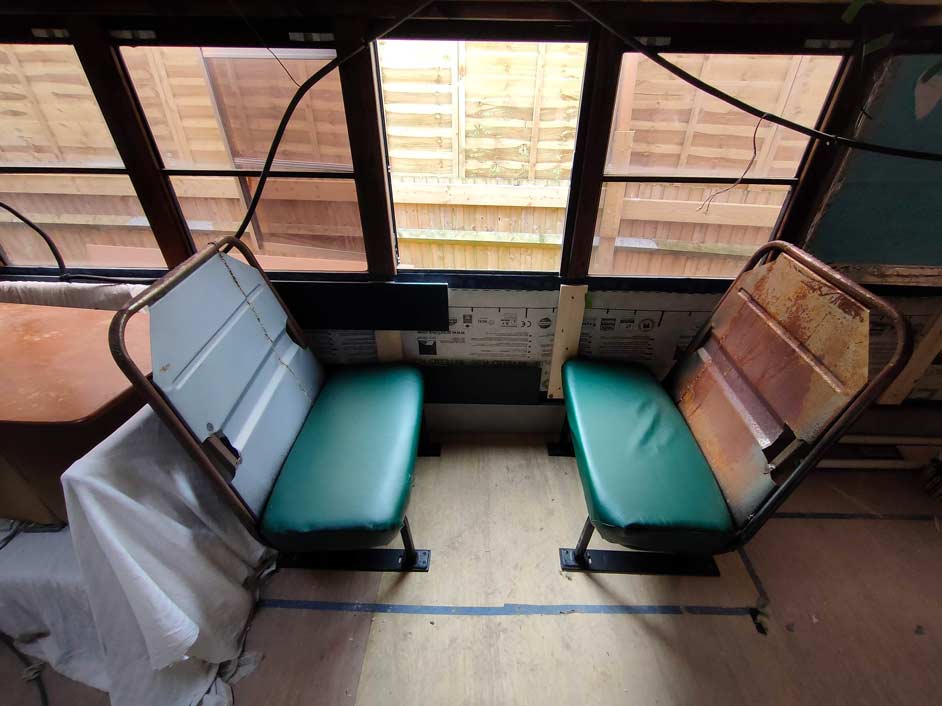
My fingers may not have been as cold as the boys but it didn’t mean I could take my foot of the pedal. In between home-schooling I painted endless panels of wood , all of which had to dry in the warmth of the house, and spent hours researching and ordering bits for the bus. It was also a chance to begin work on all the creative ideas that we had been thinking about. Home-schooling art projects began!
We wanted to reuse as much as we could from our bus and, with a whole bus load of seats at our disposal, it made sense to repurpose a couple and use them to create a dining area. Only problem is, those seats are wide – the aisle space on a US bus seems to be smaller than a UK bus. We decided to cut them down to 2/3 their original size, welding them together and reupholstering them in new vinyl to create our own American-diner. We found an original teak school table from the Wood Recycling Store, cleaned off the gum but left the graffiti, and used part of the disabled lift as a table leg to complete the look.
In for a penny - the epoxy kitchen countertop
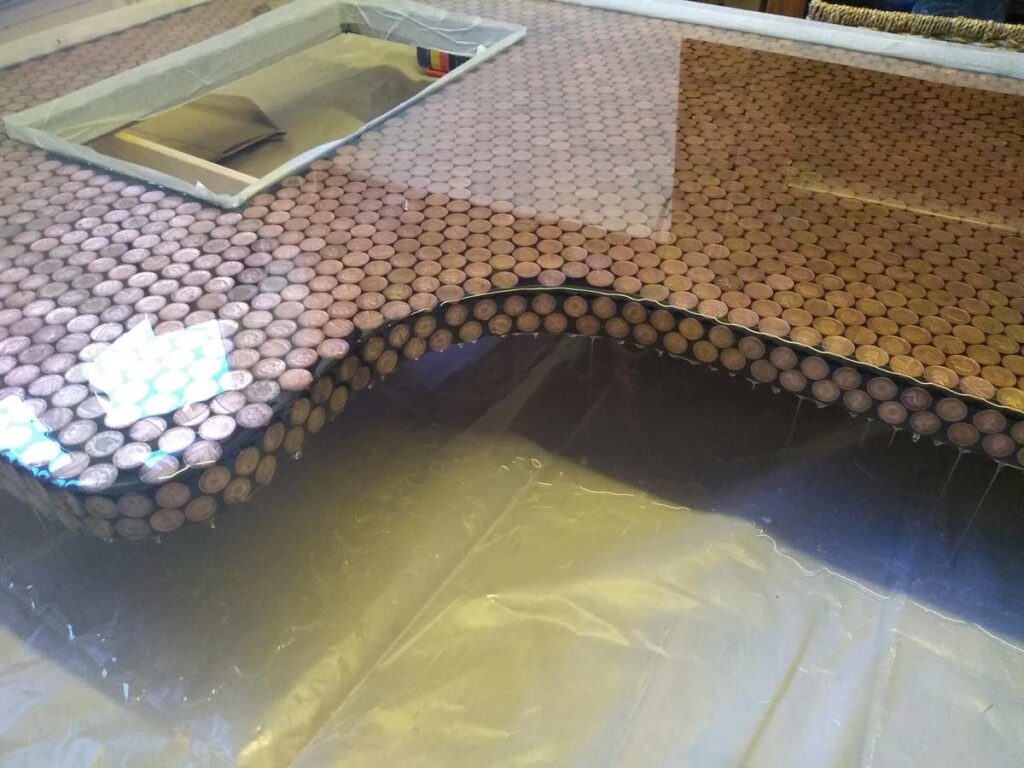
My other big ‘work from home’ project was the kitchen countertop. Whilst travelling in America, we’d helped our friends create an incredible feature shower wall with glow in the dark epoxy on pecky cypress (wood that is full of holes made by fungus… we don’t get it over in the UK, although other woods get fungus holes) and I really wanted my own epoxy project on the bus. I had in mind a river table but when I started to research it, the huge amount of epoxy you need and the seasoned live wood were prohibitively expensive. I started looking into micro-cement instead but that too was pricey. Time was running out – Neily needed to move on with the kitchen – and I was moments away from ordering a boring butcher block surface when I realised that if we did a shallow epoxy pour over an interesting surface, an epoxy countertop was do-able. Scrap the butcher block and head to the bank – I wanted pennies and lots of them!
Neily cut me the MDF base, I primed it and then set to the job of meticulously cleaning and glue-ing 3000 (ish) pennies and halfpennies to the top. Grout went on next and then it was polished. I was nervous about the epoxy pour because you only get one shot at it. You mix the epoxy and hardener to exactly the right ratio and then stir for a specific amount of time. Once you start, there is no room for error. Get your ratios wrong and it doesn’t set. Set your timer incorrectly and it gets dangerously hot. Pour it badly and you get bubbles. Cure it at the wrong temperature and it scuppers the process. Yikes. We followed the instructions to the letter! The main concern was the rolled edge – to achieve this you have to tape the edge of the countertop to form a barrier. You leave it to cure for an hour or so until it has more of a gel consistency, then remove the tape. The gel doesn’t just stream off like a liquid, so it holds its shape as it drips and eventually rolls over the edge. It was still a bit bubbly, but we chose an epoxy that degasses itself as it cures so we left it for the night. In the morning it was crystal clear and looked sooooo good. It took 24 hours to be touch dry and then a further couple of days to completely harden up. A quick sand of the now solid drips at the bottom and we were good to go. It was a week in the making, but it was worth it – it’s a triumph, even if I do say so myself!
Getting off-grid ready - solar power, compost loos and a service vehicle

We wanted the bus to be off-grid. We loved that we could just travel anywhere in the U.S, we didn’t need to plug in to survive and could stay in the wilds as long as our water tank allowed us, so our UK bus needed the same features.
With the help of some fabulous friends, we were able to install 6 solar panels. We hinged each panel on to aluminium boxing with gas struts so that they can be angled to 35 degrees, which is optimum for harvesting the low English winter sun. We will be able to generate plenty of power even on wintery days.
The other eco-arrival was our compost loo. We thought long and hard about this one. There was no doubt in our minds that a compost toilet made sense – it not only massively reduces water consumption, which means we wouldn’t require a black waste tank, we lived with one for a year and we know that they are brilliant devices for small spaces.
The concern was guests being grossed out with the idea of a campsite-style stinky long-drop. In the end we figured that we just had to change people’s minds by promoting the benefits, namely the enormous amount of water you are saving, and addressing the fears, the biggest one being that they smell. They don’t at all. The liquids and solids mixing together is the main culprit of the lingering smells and with a compost toilet like ours, they are separated. Guy has fitted a tank under the bus for the liquids. The solids go into a container that is vented to the outside. A scoop of sawdust to hide the evidence and a sliding lid to cover the container, and you can walk away confident of no smells.
Our toilet choice was a Simploo, a UK make. They have been really helpful and their customer service is also top notch. We are pretty sure we will win our guests round with their product.
Adding design flair with repurposed wood, upcycled metal and an evolving cool colour pallette

From the beginning of the build we tried to make the most of the materials around us, re-using parts of the bus as I’ve mentioned, but also upcycling things we found along the way and hunting for the perfect pieces in second-hand stores.
Gumtree, Facebook Marketplace and Ebay were my friends. Scouring through other people’s trash produced bus treasure which came with fascinating stories or brought us new followers. Our perfectly-sized Scandi leather sofa belonged to a local man who would chill out and relax on it as the tunes played from his fabulous Wurlitzer. Our retro leather pouffe came from a lady who was thrilled to find out that her beloved footstool (which didn’t fit her house) was going to move to a Skoolie. She was so inspired by our story that she went on to become one of our first bookings.
The ‘treasures’ often evolved to be something entirely different. The old doors we picked up that were too heavy for us to use, turned out to be made from American oak slats that we were able to plane down and use to frame our old bus mirror as part of a feature wall, and a kitchen cabinet. A water-damaged teak futon was dismantled and brought back to life as a sliding barn door for the bathroom. The hardwood pallets were used for framing the hatches and even our cutting table from the build was chopped up to be turned into shelves, held up by a huge bit of driftwood we found on the beach. To smooth out the cut marks, I filled in the gaps with leftover epoxy and glow in the dark paint.
With practically everything finished, it was time to paint. Our original choice of green was developed to create a pallette that matched the wood and copper tones. We added copper and cream paints and fittings and shopped for soft furnishings in soft greys, earthy maroons and teals with the occasional accent of orange because I’d found a fabulous retro Le Creuset ‘volcano’ kettle!
I spent the evenings sewing cushion covers that would tie everything together while the boys worked on their last big project: the murphy bunks.
The murphy bunks and the king-size bed
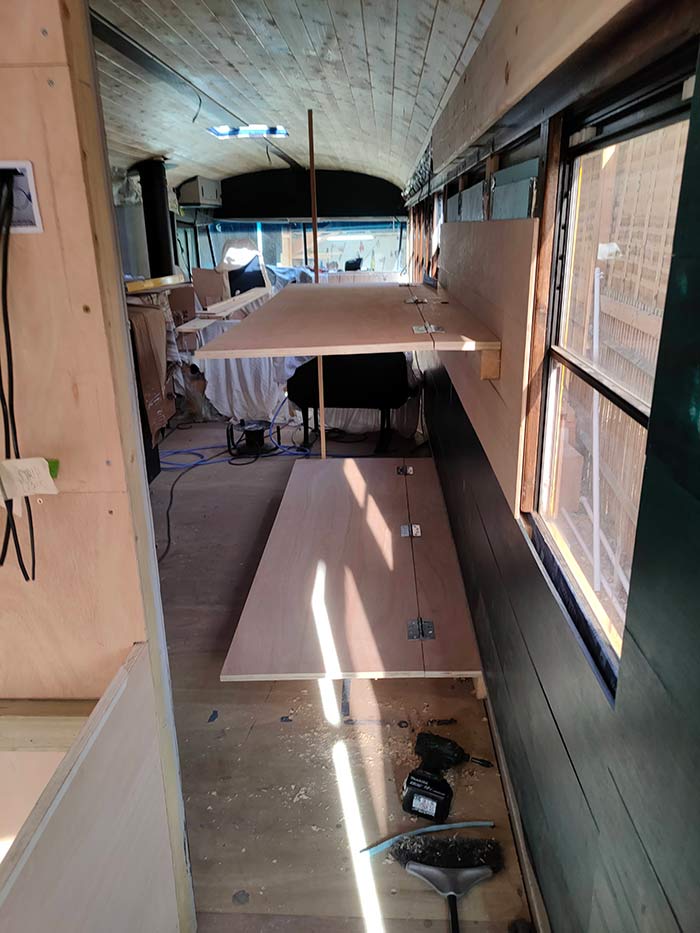
In America, the boys bunks were the worst part of the Skoolie. Our son summed it up:
“They were like coffins! You could barely sit up and there was no air – they sucked”!
Considering they were only being used to sleep in, they took up an enormous amount of space. We knew we wanted to do something different with our UK bus.
Murphy bunks fold out from the wall, which means they have a much smaller footprint. Friends of ours have ones in which the top bunk drops down to become the back of a sofa (the bottom bunk), but though we liked the design we knew we wanted to keep the sleeping area separate from the living space.
Guy and Neily excelled themselves with the design and build. They are roomy, comfy and really easy to put up and down because they are assisted with gas struts. It makes a huge difference to the space being able to close them up when they are not in use. And, judging by the social media comments, they are loved as much as the epoxy counter!
The last thing we brought in was the king-size bed mattress and slats. Underneath the bed is the pipework, diesel heater, batteries and the water tank so this was a key working area for much of the build. It was only right at the end that we added the wooden slats and finally brought in the comfy Inofia mattress, transforming it from a work zone to something beautiful and tranquil. The slats sit on a frame so we can lift the whole bed up to access the pipework if ever we need to.
Laying the floor and the deck

All that was missing was the floor. Or should I say, a couple of square metres of floor.
Way back at the start of the build I’d sourced 10sqm of old wooden flooring that someone had bought and no longer needed. It was gorgeous engineered, top of the range, oak herringbone-style slats. The problem was, when we took it out the boxes, we only had 6sqm. Gutted…. we needed 8sqm. Would we really have to source something new?
Buying expensive items at the start of a build, when you have the time to shop around, is much easier on the wallet than at the end of a build. We had neither time or finances on our side so I thought I’d try my luck and source the supplier to see if they would help us out with the last 2sqm. I found their name on the side of one of the boxes – Havwoods – and got in touch to see if they still stocked the wood.
Joy of joys, Havwoods still had stock. And, joy of even bigger joys, they loved our Skoolie so much they agreed to sponsor the last corner of the bus so that we could have our beautiful floor without breaking our budget. They even posted up an interview with us on their site. It looks freaking awesome – the shades and patterns of the wooden planks brought together all of the angular designs and warm tones we had used throughout the build. We couldn’t have been happier with the result.
The last thing to arrive was our deck. For this, Tristan, a local lad from Firle area, stepped in to help. He was brilliant and developed the original plan to improve the layout and functionality. It is amazing to be able to walk straight out from the bedroom onto a private sun deck – better than we even imagined and the perfect way to end our build.
The finished Skoolie!
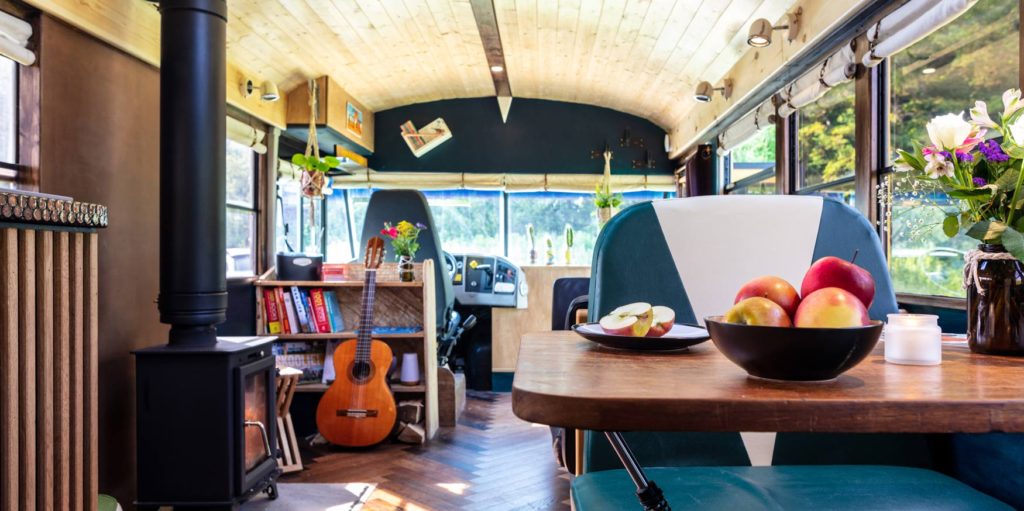
We are both so proud of what we have achieved – what a journey, what a finish and what a result: we own our very own fantastic Skoolie again.
